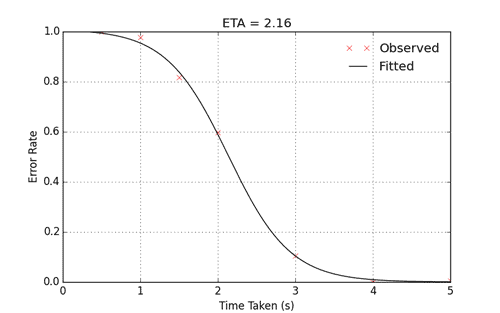The ETA framework is a Javascript library that you can use to compute the difficulty of an Amazon Mechanical Turk task. It computes the error-time curve and error-time area under the curve (ETA) for the task. More specifically, ETA is a measure that takes into account both the time workers take to complete a task, and their accuracy in doing so.
More details are provided in this paper.
See a demonstration of the interface ETA generates to evaluate the difficulty of a task. By running this task on Mechanical Turk, the ETA framework can generate an error-time curve, and compute the ETA for a task:
More examples of such curves can be found in the paper.
ETA requires Python, numpy, scipy, and matplotlib.
The key idea behind ETA is to limit the amount of time workers have to complete a task, and measure worker accuracy given different time limits. Thus, given a task, we observe worker performance on the same task under several different time limits.
In this tutorial, we'll aim to measure the ETA of a multiple-choice question, where the goal is to pick the label that best describes an image. The files used in this tutorial can be found in the examples/multiple_choice_remote folder.
First, let's look at mturk.html. Every task is composed of a task template and the task's options. Here's a simplified version of this task's template:
<div class="base_q">
<div><img src="#IMG_URL#"></div>
<div>
Pick a label that best applies to this image.
<label><input type="radio" name="answer" value="#LABEL1#"> #LABEL1#</label>
<label><input type="radio" name="answer" value="#LABEL2#"> #LABEL2#</label>
<label><input type="radio" name="answer" value="#LABEL3#"> #LABEL3#</label>
<label><input type="radio" name="answer" value="#LABEL4#"> #LABEL4#</label>
</div>
</div>
The task options for this task are also defined in mturk.html:
var question_metadata = {
time_limits: [0.5, 1.0, 1.5, 2.0, 3.0, 4.0, 5.0], # Possible time limits
num_reps: [3, 3, 3, 3, 3, 3, 3], # Number of repetitions for each time limit
practice_time_limit: 8, # Time limit for the practice questions
practice_num_reps: 3 # Number of Practice Questions
};
Here, I'm guessing that people may take anywhere from 0.5 to 5 seconds to complete this task, so I've defined seven time limits in that range. In practice, you'll want at least seven unique time limits to generate a reliable error-time curve.
You'll also need data to populate the HTML template above. data.csv is similar to what you might upload to Mechanical Turk for a regular task, only now you provide it directly to the ETA framework.
IMG_URL,LABEL1,LABEL2,LABEL3,LABEL4,ANSWER
http://...png,jumping,waving,climbing,brushing,waving
http://...png,eating,cooking,waving,jumping,jumping
...
Note that the columns in this CSV file correspond to the variables defined in the template (e.g., "IMGURL" and "LABEL1"). The correct answer for a question defined in the "ANSWER" column, and the input name in the template is correspondingly "answer".
To generate a JSON file so that ETA can parse this data, you can run python ../../releases/generate_json.py in the example directory, which will generate the data.json file. generate_json.py removes the answer column(s) so that workers aren't able to inspect the HTML to see the correct answers to the questions.
In this example, data is remotely served using get.php, so that we don't need to directly include the data in the task file. However, you can also directly include data in the task file (see the multiple_choice example instead).
Now, we paste the code in mturk.html as HTML source into a Mechanical Turk task:
We then run this task, and finally download the output CSV from Mechanical Turk (results.csv) when the task completes.
Finally, we can run python ../../releases/process.py in the example directory to obtain the error-time curve and ETA for the task (See python process.py -h for more help). Three files will be generated:
eta.png- A plot of the generated ETA curveeta.csv- The processed data used to generate the curveeta.txt- Additional useful information
The examples folder contains sample code for how this library can be used.
multiple-choice- Multiple choice taskmultiple-choice-remote- Multiple choice task, with data loaded remotely
- The latest version of the code is hosted on http://clr3.com for easy inclusion in Mechanical Turk tasks. If you'd like to host your own version, note that your web server must be https-enabled.
If you are interested in contributing to the development of ETA, keep reading!
Source files are included in the src folder. To build ETA, first run these commands:
brew install node
npm install clean-css -g
pip install pyminifier
and then run ./build.sh from src, which will output ETA to the releases folder.
ETA is released under the MIT License.

